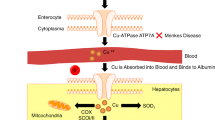Summary
An iron binding protein was isolated from crab blood and tested for its chemical and functional behavior.
-
1.
The protein has a molecular weight of 150,000±10,000 and consists of a single polypeptide chain. The iron content was found to be two molecules iron per molecule protein; the presence of a 52-fold molar excess of copper did not alter the iron binding properties.
-
2.
Spectroscopical analysis carried out in the presence of bicarbonate yielded two absorption maxima at λ=276 and λ=465 nm.
-
3.
The59Fe-tagged crab protein did not yield its iron to human apotransferrin when incubated in human plasma. When incubated with rat reticulocytes, the crab iron protein delivered its iron for hemoglobin and ferritin synthesis. This delivery can be completely abolished by adding an excess of rat transferrin.
-
4.
When injected into rats in vivo, the crab protein delivered its iron to erythroid and non-erythroid tissue. The amount delivered to the erythroid marrow was shown to depend on iron requirements of that tissue.
-
5.
When injected as59Fe-tagged protein into a crab, half-time disappearance of the radioiron is reached between 7 and 9 h. In the liver and in the carapace lining, the radioiron released is found in other iron binders.
-
6.
Except for the significantly larger molecular weight, the crab iron binding protein fulfills all the criteria for transferrin. The findings negate the concept that transferrin is a newcomer in the evolutionary scene and to be found only in the phylum Chordata. Thus the need for a specific iron transport protein of the transferrin class is independent of the achievement of hemoglobin as a means to accomplish oxygen transport.
Similar content being viewed by others
Abbreviations
- UIBC :
-
unsaturated iron binding capacity
References
Aisen P, Brown EB (1975) Structure and function of transferrin. Prog Hematol 9:25–56
Aisen P, Listowsky I (1980) Iron transport and storage proteins. Annu Rev Biochem 49:357–393
Beck MT (1978) Prebiotic coordination chemistry. In: Sigel H (ed) Metal ions in biological systems, chap 1, vol 7. Dekker, New York
Brock JH (1980) Lactoferrin in human milk: its role in iron absorption and protection against enteric infection in the newborn infant. Arch Dis Child 55:417–421
Eakins JD, Brown EA (1966) An improved method for the simultaneous determination of iron-55 and iron-59 in blood by liquid scintillation counting. Int J Appl Radiat Isot 17:391–397
Heilmeyer L von, Keller W, Vivell D, Keiderling W, Betke K, Wöhler F, Schulke HE (1961) Kongenitale Atransferrinaemie bei einem sieben Jahre alten Kind. Dtsch Med Wochenschr 86:1745–1751
Huebers H, Huebers E, Rummel W, Crichton RR (1976) Isolation and characterization of iron binding proteins from rat intestinal mucosa. Eur J Biochem 66:447–455
Huebers H, Huebers E, Csiba E, Finch CA (1978) Iron uptake from rat plasma transferrin by rat reticulocytes. J Clin Invest 62:944–951
Huebers H, Csiba E, Josephson B, Huebers E, Finch CA (1981a) Interaction of human diferric transferrin with reticulocytes. Proc Natl Acad Sci USA 78:621–625
Huebers H, Josephson B, Huebers E, Csiba E, Finch CA (1981b) Uptake and release of iron from human transferrin. Proc Natl Acad Sci USA 78:2572–2576
International Commitee for Standardization in Hematology (1978) Recommendation for measurement of serum iron in human blood. Br J Haematol 38:291–294
Keilin D (1925) On cytochrome, a respiratory pigment, common to animals, yeast and higher plants. Proc Soc Lond [Biol] 98:312–339
Labbe RF, Nishida G (1957) A new method of hemin isolation. Biochem Biophys Acta 26:437
Lee MY, Huebers H, Martin AW, Finch CA (1978) Iron metabolism in a spider,Dugesiella hentzi. J Comp Physiol 127:349–354
MacMunn CA (1886) Researches on Myohaematins and the Histohaematins. Philos Trans Soc Lond [Biol] 177:267–298
Morgan EH, Huebers H, Finch CA (1978) Differences between the binding sites for iron binding and release in human and rat transferrin. Blood 52:1219–1228
Nakos K, Mortenson L (1971) Subunit structure of azoferredoxin fromClostridium pasteurianum w5. Biochemistry 10:455–458
Spector T (1977) Quantitation of microgram amounts of protein in SDS-mercaptoethanol-Tris electrophoresis sample buffer. Anal Biochem 83:773–777
Tan AT, Woodworth RC (1969) Ultraviolet difference spectral studies of conalbumin complexes with transition metal ions. Biochemistry 8:3711–3716
Vinogradov AP (1953) The elementary chemical composition of marine organisms. Sears Foundation, New Haven, Connecticut (Translated from the Russian by Efron J, Setlow JK)
Williams AJ, Lutz PL (1975) The role of the haemolymph in the carbohydrate metabolism ofCarcinus maanas. J Mar Biol Assoc UK 55:667–670
Author information
Authors and Affiliations
Additional information
Dedicated to Prof. Rummel from the University of Homburg-Saar (FRG) on the occasion of his 60th birthday
Rights and permissions
About this article
Cite this article
Huebers, H.A., Huebers, E., Finch, C.A. et al. Characterization of an invertebrate transferrin from the crabCancer magister (Arthropoda). Journal of Comparative Physiology B 148, 101–109 (1982). https://doi.org/10.1007/BF00688893
Accepted:
Issue Date:
DOI: https://doi.org/10.1007/BF00688893




